Impact of Facebook on Employee Selection and Marketing
VerifiedAdded on 2023/03/31
|5
|1287
|78
AI Summary
This article discusses the impact of Facebook on employee selection and marketing of products and services. It explores the potential benefits and risks of implementing social technology in the workplace.
Contribute Materials
Your contribution can guide someone’s learning journey. Share your
documents today.
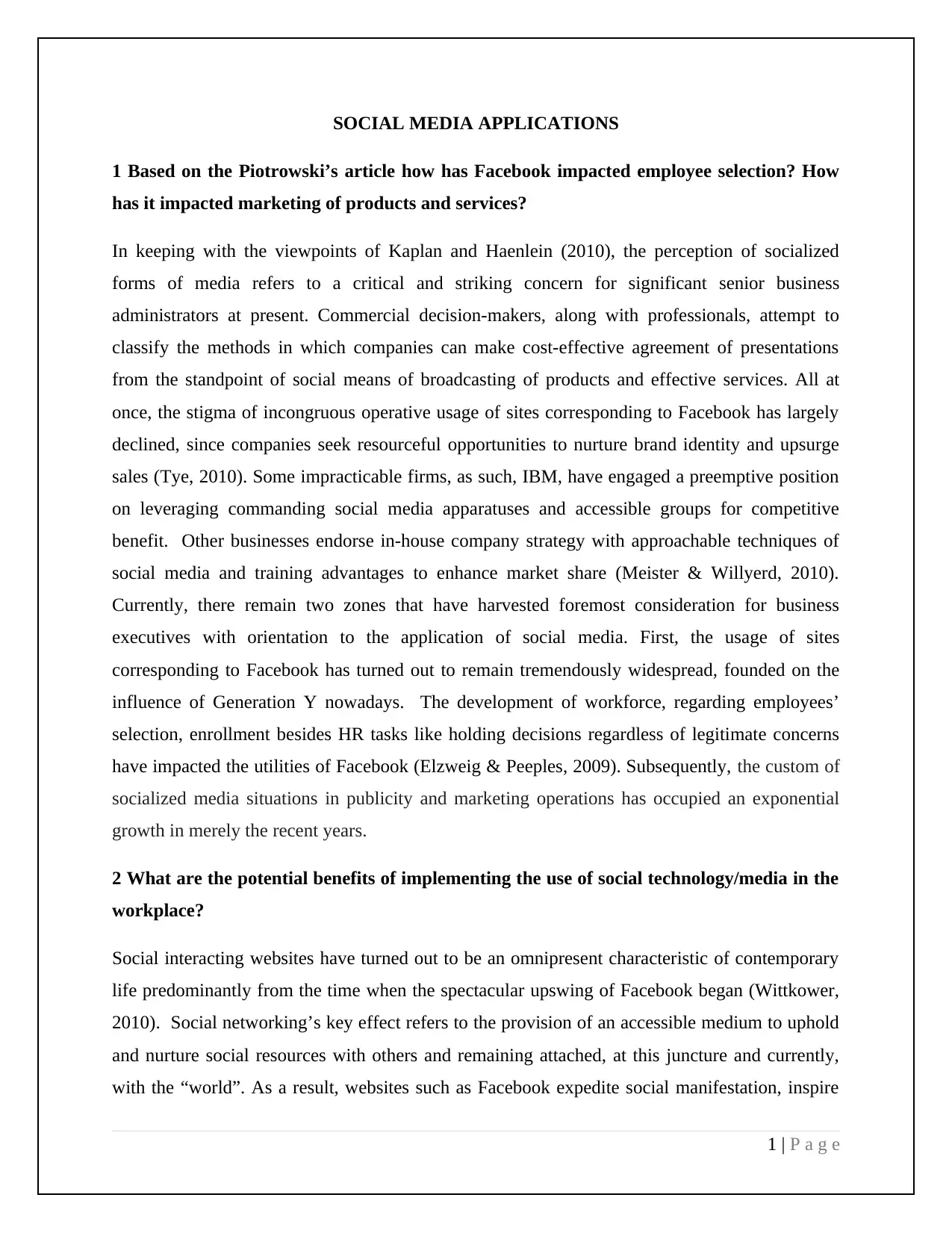
SOCIAL MEDIA APPLICATIONS
1 Based on the Piotrowski’s article how has Facebook impacted employee selection? How
has it impacted marketing of products and services?
In keeping with the viewpoints of Kaplan and Haenlein (2010), the perception of socialized
forms of media refers to a critical and striking concern for significant senior business
administrators at present. Commercial decision-makers, along with professionals, attempt to
classify the methods in which companies can make cost-effective agreement of presentations
from the standpoint of social means of broadcasting of products and effective services. All at
once, the stigma of incongruous operative usage of sites corresponding to Facebook has largely
declined, since companies seek resourceful opportunities to nurture brand identity and upsurge
sales (Tye, 2010). Some impracticable firms, as such, IBM, have engaged a preemptive position
on leveraging commanding social media apparatuses and accessible groups for competitive
benefit. Other businesses endorse in-house company strategy with approachable techniques of
social media and training advantages to enhance market share (Meister & Willyerd, 2010).
Currently, there remain two zones that have harvested foremost consideration for business
executives with orientation to the application of social media. First, the usage of sites
corresponding to Facebook has turned out to remain tremendously widespread, founded on the
influence of Generation Y nowadays. The development of workforce, regarding employees’
selection, enrollment besides HR tasks like holding decisions regardless of legitimate concerns
have impacted the utilities of Facebook (Elzweig & Peeples, 2009). Subsequently, the custom of
socialized media situations in publicity and marketing operations has occupied an exponential
growth in merely the recent years.
2 What are the potential benefits of implementing the use of social technology/media in the
workplace?
Social interacting websites have turned out to be an omnipresent characteristic of contemporary
life predominantly from the time when the spectacular upswing of Facebook began (Wittkower,
2010). Social networking’s key effect refers to the provision of an accessible medium to uphold
and nurture social resources with others and remaining attached, at this juncture and currently,
with the “world”. As a result, websites such as Facebook expedite social manifestation, inspire
1 | P a g e
1 Based on the Piotrowski’s article how has Facebook impacted employee selection? How
has it impacted marketing of products and services?
In keeping with the viewpoints of Kaplan and Haenlein (2010), the perception of socialized
forms of media refers to a critical and striking concern for significant senior business
administrators at present. Commercial decision-makers, along with professionals, attempt to
classify the methods in which companies can make cost-effective agreement of presentations
from the standpoint of social means of broadcasting of products and effective services. All at
once, the stigma of incongruous operative usage of sites corresponding to Facebook has largely
declined, since companies seek resourceful opportunities to nurture brand identity and upsurge
sales (Tye, 2010). Some impracticable firms, as such, IBM, have engaged a preemptive position
on leveraging commanding social media apparatuses and accessible groups for competitive
benefit. Other businesses endorse in-house company strategy with approachable techniques of
social media and training advantages to enhance market share (Meister & Willyerd, 2010).
Currently, there remain two zones that have harvested foremost consideration for business
executives with orientation to the application of social media. First, the usage of sites
corresponding to Facebook has turned out to remain tremendously widespread, founded on the
influence of Generation Y nowadays. The development of workforce, regarding employees’
selection, enrollment besides HR tasks like holding decisions regardless of legitimate concerns
have impacted the utilities of Facebook (Elzweig & Peeples, 2009). Subsequently, the custom of
socialized media situations in publicity and marketing operations has occupied an exponential
growth in merely the recent years.
2 What are the potential benefits of implementing the use of social technology/media in the
workplace?
Social interacting websites have turned out to be an omnipresent characteristic of contemporary
life predominantly from the time when the spectacular upswing of Facebook began (Wittkower,
2010). Social networking’s key effect refers to the provision of an accessible medium to uphold
and nurture social resources with others and remaining attached, at this juncture and currently,
with the “world”. As a result, websites such as Facebook expedite social manifestation, inspire
1 | P a g e
Secure Best Marks with AI Grader
Need help grading? Try our AI Grader for instant feedback on your assignments.
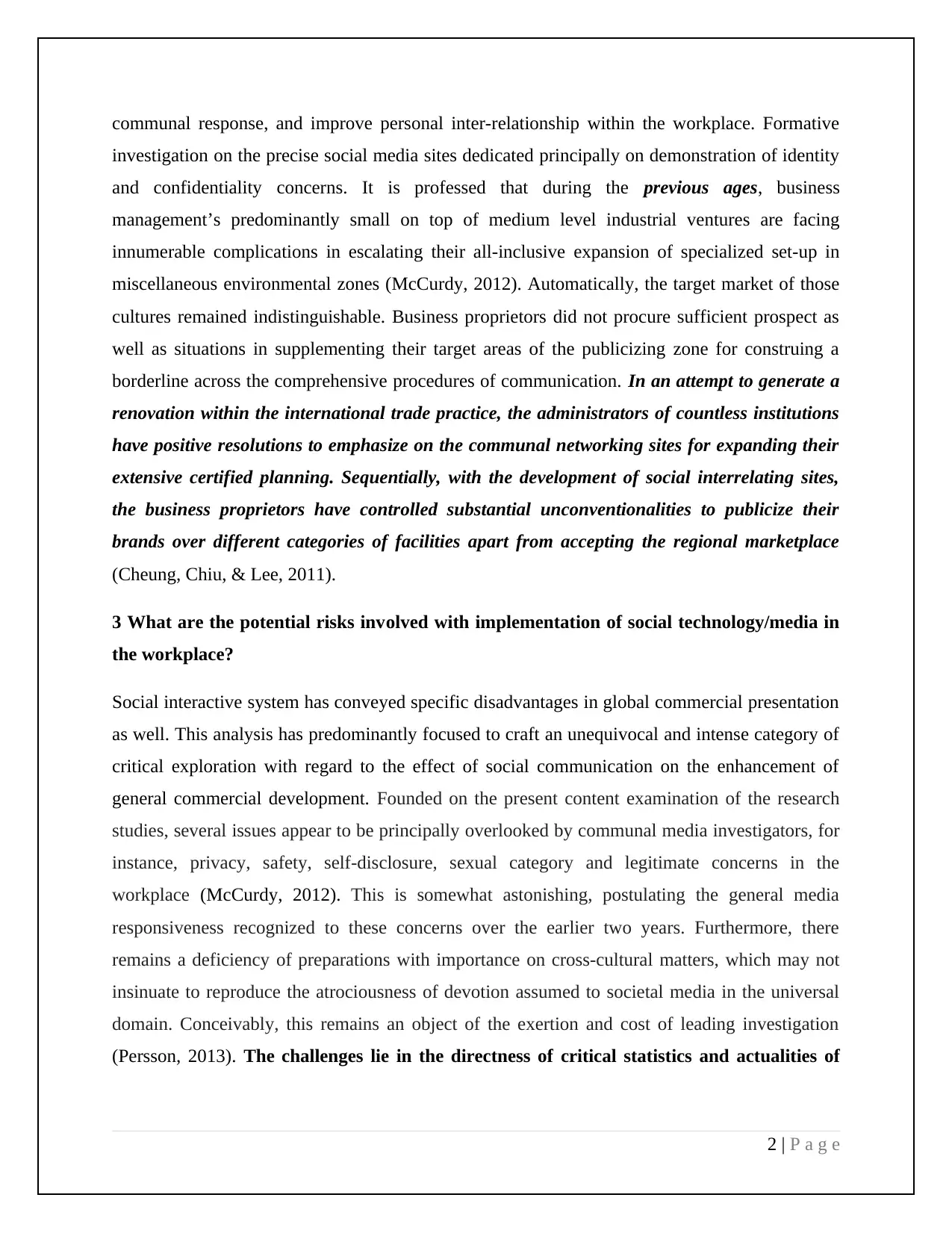
communal response, and improve personal inter-relationship within the workplace. Formative
investigation on the precise social media sites dedicated principally on demonstration of identity
and confidentiality concerns. It is professed that during the previous ages, business
management’s predominantly small on top of medium level industrial ventures are facing
innumerable complications in escalating their all-inclusive expansion of specialized set-up in
miscellaneous environmental zones (McCurdy, 2012). Automatically, the target market of those
cultures remained indistinguishable. Business proprietors did not procure sufficient prospect as
well as situations in supplementing their target areas of the publicizing zone for construing a
borderline across the comprehensive procedures of communication. In an attempt to generate a
renovation within the international trade practice, the administrators of countless institutions
have positive resolutions to emphasize on the communal networking sites for expanding their
extensive certified planning. Sequentially, with the development of social interrelating sites,
the business proprietors have controlled substantial unconventionalities to publicize their
brands over different categories of facilities apart from accepting the regional marketplace
(Cheung, Chiu, & Lee, 2011).
3 What are the potential risks involved with implementation of social technology/media in
the workplace?
Social interactive system has conveyed specific disadvantages in global commercial presentation
as well. This analysis has predominantly focused to craft an unequivocal and intense category of
critical exploration with regard to the effect of social communication on the enhancement of
general commercial development. Founded on the present content examination of the research
studies, several issues appear to be principally overlooked by communal media investigators, for
instance, privacy, safety, self-disclosure, sexual category and legitimate concerns in the
workplace (McCurdy, 2012). This is somewhat astonishing, postulating the general media
responsiveness recognized to these concerns over the earlier two years. Furthermore, there
remains a deficiency of preparations with importance on cross-cultural matters, which may not
insinuate to reproduce the atrociousness of devotion assumed to societal media in the universal
domain. Conceivably, this remains an object of the exertion and cost of leading investigation
(Persson, 2013). The challenges lie in the directness of critical statistics and actualities of
2 | P a g e
investigation on the precise social media sites dedicated principally on demonstration of identity
and confidentiality concerns. It is professed that during the previous ages, business
management’s predominantly small on top of medium level industrial ventures are facing
innumerable complications in escalating their all-inclusive expansion of specialized set-up in
miscellaneous environmental zones (McCurdy, 2012). Automatically, the target market of those
cultures remained indistinguishable. Business proprietors did not procure sufficient prospect as
well as situations in supplementing their target areas of the publicizing zone for construing a
borderline across the comprehensive procedures of communication. In an attempt to generate a
renovation within the international trade practice, the administrators of countless institutions
have positive resolutions to emphasize on the communal networking sites for expanding their
extensive certified planning. Sequentially, with the development of social interrelating sites,
the business proprietors have controlled substantial unconventionalities to publicize their
brands over different categories of facilities apart from accepting the regional marketplace
(Cheung, Chiu, & Lee, 2011).
3 What are the potential risks involved with implementation of social technology/media in
the workplace?
Social interactive system has conveyed specific disadvantages in global commercial presentation
as well. This analysis has predominantly focused to craft an unequivocal and intense category of
critical exploration with regard to the effect of social communication on the enhancement of
general commercial development. Founded on the present content examination of the research
studies, several issues appear to be principally overlooked by communal media investigators, for
instance, privacy, safety, self-disclosure, sexual category and legitimate concerns in the
workplace (McCurdy, 2012). This is somewhat astonishing, postulating the general media
responsiveness recognized to these concerns over the earlier two years. Furthermore, there
remains a deficiency of preparations with importance on cross-cultural matters, which may not
insinuate to reproduce the atrociousness of devotion assumed to societal media in the universal
domain. Conceivably, this remains an object of the exertion and cost of leading investigation
(Persson, 2013). The challenges lie in the directness of critical statistics and actualities of
2 | P a g e
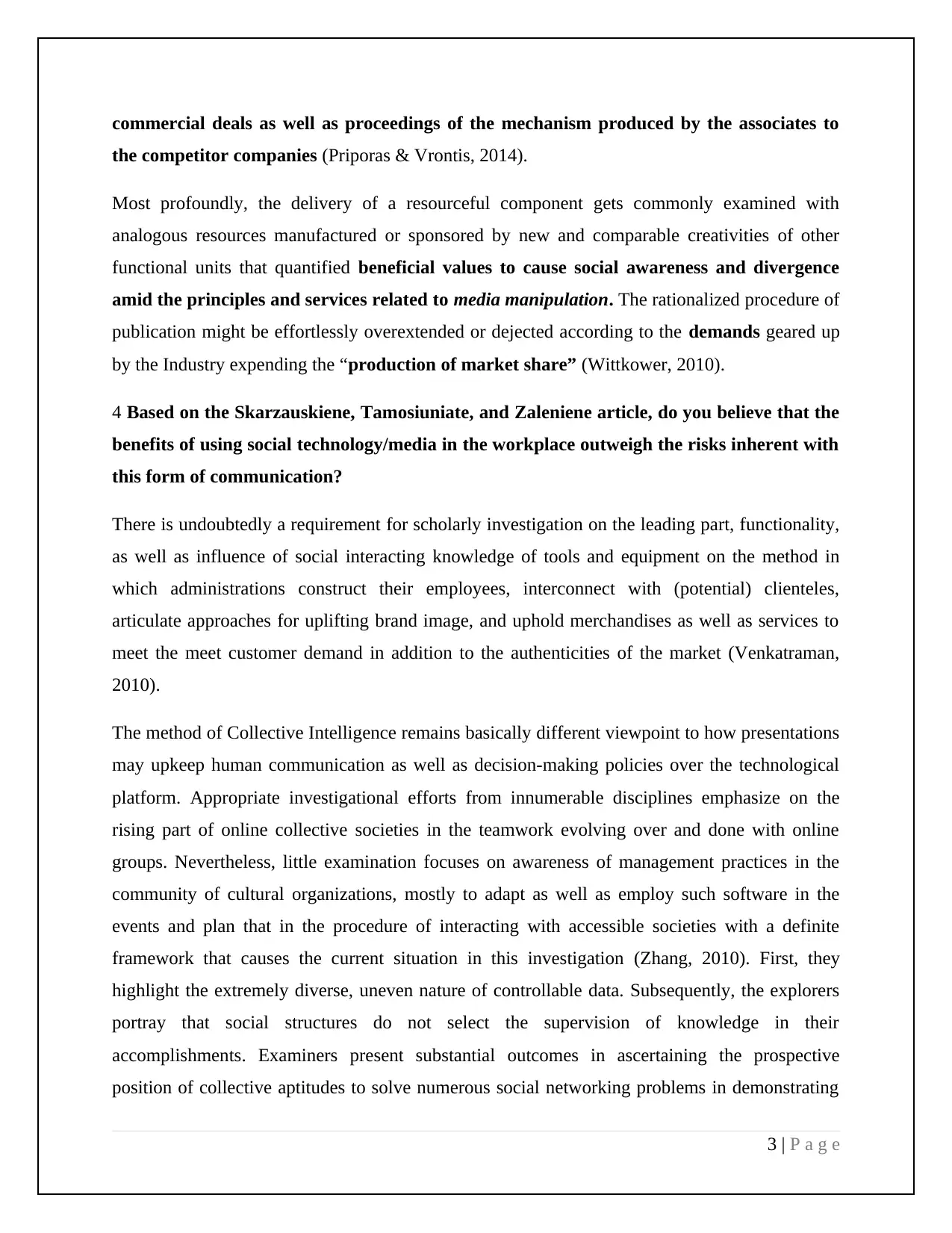
commercial deals as well as proceedings of the mechanism produced by the associates to
the competitor companies (Priporas & Vrontis, 2014).
Most profoundly, the delivery of a resourceful component gets commonly examined with
analogous resources manufactured or sponsored by new and comparable creativities of other
functional units that quantified beneficial values to cause social awareness and divergence
amid the principles and services related to media manipulation. The rationalized procedure of
publication might be effortlessly overextended or dejected according to the demands geared up
by the Industry expending the “production of market share” (Wittkower, 2010).
4 Based on the Skarzauskiene, Tamosiuniate, and Zaleniene article, do you believe that the
benefits of using social technology/media in the workplace outweigh the risks inherent with
this form of communication?
There is undoubtedly a requirement for scholarly investigation on the leading part, functionality,
as well as influence of social interacting knowledge of tools and equipment on the method in
which administrations construct their employees, interconnect with (potential) clienteles,
articulate approaches for uplifting brand image, and uphold merchandises as well as services to
meet the meet customer demand in addition to the authenticities of the market (Venkatraman,
2010).
The method of Collective Intelligence remains basically different viewpoint to how presentations
may upkeep human communication as well as decision-making policies over the technological
platform. Appropriate investigational efforts from innumerable disciplines emphasize on the
rising part of online collective societies in the teamwork evolving over and done with online
groups. Nevertheless, little examination focuses on awareness of management practices in the
community of cultural organizations, mostly to adapt as well as employ such software in the
events and plan that in the procedure of interacting with accessible societies with a definite
framework that causes the current situation in this investigation (Zhang, 2010). First, they
highlight the extremely diverse, uneven nature of controllable data. Subsequently, the explorers
portray that social structures do not select the supervision of knowledge in their
accomplishments. Examiners present substantial outcomes in ascertaining the prospective
position of collective aptitudes to solve numerous social networking problems in demonstrating
3 | P a g e
the competitor companies (Priporas & Vrontis, 2014).
Most profoundly, the delivery of a resourceful component gets commonly examined with
analogous resources manufactured or sponsored by new and comparable creativities of other
functional units that quantified beneficial values to cause social awareness and divergence
amid the principles and services related to media manipulation. The rationalized procedure of
publication might be effortlessly overextended or dejected according to the demands geared up
by the Industry expending the “production of market share” (Wittkower, 2010).
4 Based on the Skarzauskiene, Tamosiuniate, and Zaleniene article, do you believe that the
benefits of using social technology/media in the workplace outweigh the risks inherent with
this form of communication?
There is undoubtedly a requirement for scholarly investigation on the leading part, functionality,
as well as influence of social interacting knowledge of tools and equipment on the method in
which administrations construct their employees, interconnect with (potential) clienteles,
articulate approaches for uplifting brand image, and uphold merchandises as well as services to
meet the meet customer demand in addition to the authenticities of the market (Venkatraman,
2010).
The method of Collective Intelligence remains basically different viewpoint to how presentations
may upkeep human communication as well as decision-making policies over the technological
platform. Appropriate investigational efforts from innumerable disciplines emphasize on the
rising part of online collective societies in the teamwork evolving over and done with online
groups. Nevertheless, little examination focuses on awareness of management practices in the
community of cultural organizations, mostly to adapt as well as employ such software in the
events and plan that in the procedure of interacting with accessible societies with a definite
framework that causes the current situation in this investigation (Zhang, 2010). First, they
highlight the extremely diverse, uneven nature of controllable data. Subsequently, the explorers
portray that social structures do not select the supervision of knowledge in their
accomplishments. Examiners present substantial outcomes in ascertaining the prospective
position of collective aptitudes to solve numerous social networking problems in demonstrating
3 | P a g e
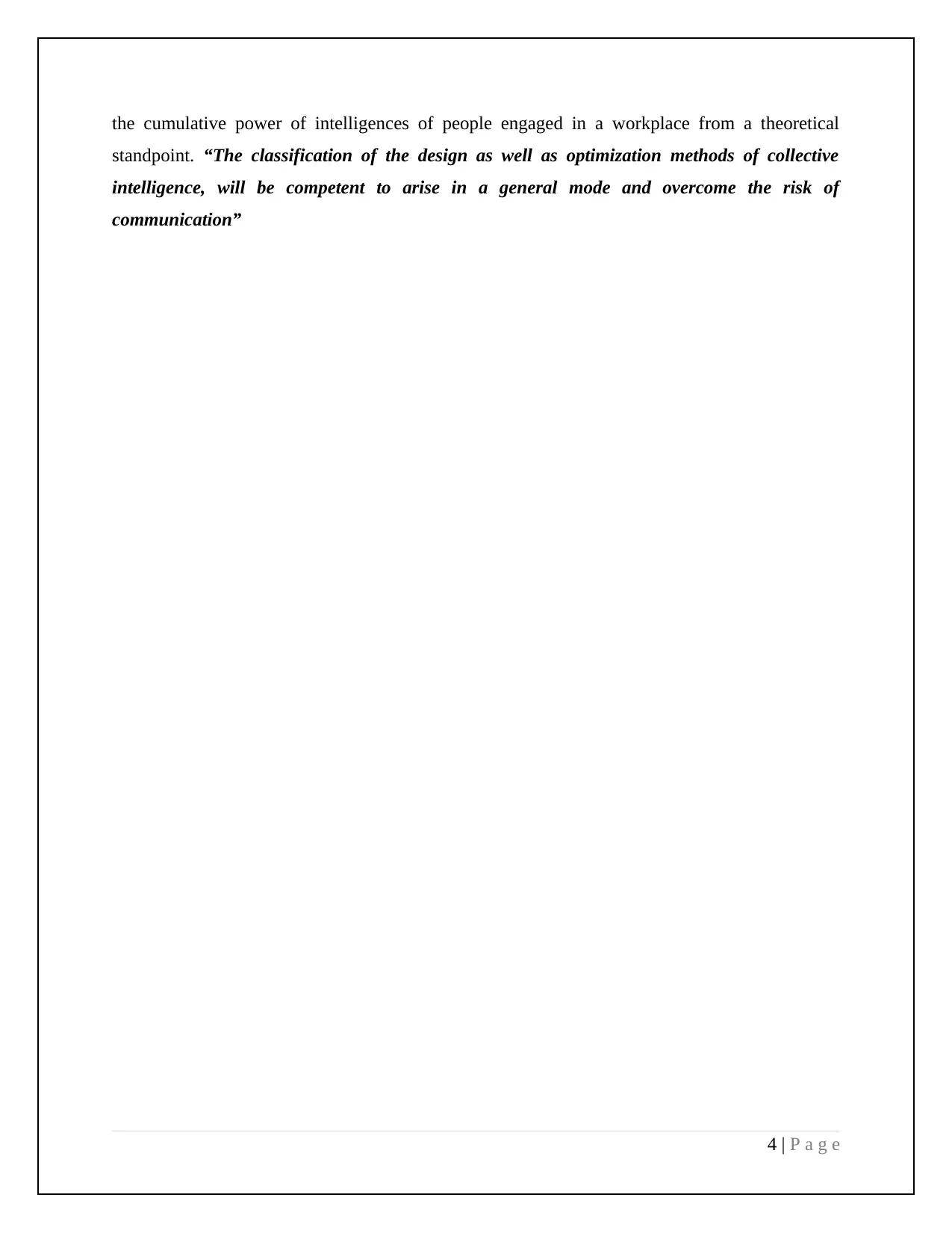
the cumulative power of intelligences of people engaged in a workplace from a theoretical
standpoint. “The classification of the design as well as optimization methods of collective
intelligence, will be competent to arise in a general mode and overcome the risk of
communication”
4 | P a g e
standpoint. “The classification of the design as well as optimization methods of collective
intelligence, will be competent to arise in a general mode and overcome the risk of
communication”
4 | P a g e
Secure Best Marks with AI Grader
Need help grading? Try our AI Grader for instant feedback on your assignments.
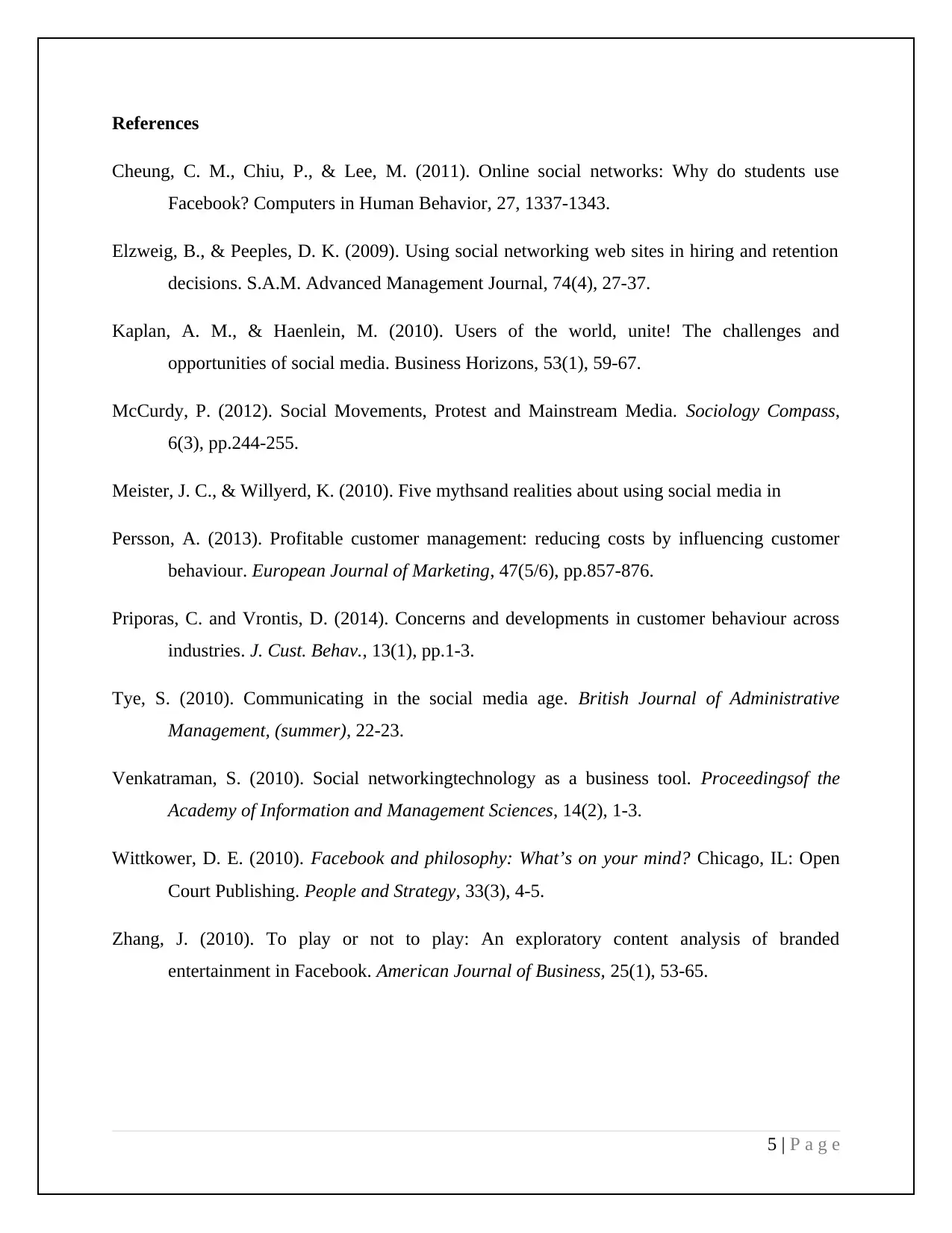
References
Cheung, C. M., Chiu, P., & Lee, M. (2011). Online social networks: Why do students use
Facebook? Computers in Human Behavior, 27, 1337-1343.
Elzweig, B., & Peeples, D. K. (2009). Using social networking web sites in hiring and retention
decisions. S.A.M. Advanced Management Journal, 74(4), 27-37.
Kaplan, A. M., & Haenlein, M. (2010). Users of the world, unite! The challenges and
opportunities of social media. Business Horizons, 53(1), 59-67.
McCurdy, P. (2012). Social Movements, Protest and Mainstream Media. Sociology Compass,
6(3), pp.244-255.
Meister, J. C., & Willyerd, K. (2010). Five mythsand realities about using social media in
Persson, A. (2013). Profitable customer management: reducing costs by influencing customer
behaviour. European Journal of Marketing, 47(5/6), pp.857-876.
Priporas, C. and Vrontis, D. (2014). Concerns and developments in customer behaviour across
industries. J. Cust. Behav., 13(1), pp.1-3.
Tye, S. (2010). Communicating in the social media age. British Journal of Administrative
Management, (summer), 22-23.
Venkatraman, S. (2010). Social networkingtechnology as a business tool. Proceedingsof the
Academy of Information and Management Sciences, 14(2), 1-3.
Wittkower, D. E. (2010). Facebook and philosophy: What’s on your mind? Chicago, IL: Open
Court Publishing. People and Strategy, 33(3), 4-5.
Zhang, J. (2010). To play or not to play: An exploratory content analysis of branded
entertainment in Facebook. American Journal of Business, 25(1), 53-65.
5 | P a g e
Cheung, C. M., Chiu, P., & Lee, M. (2011). Online social networks: Why do students use
Facebook? Computers in Human Behavior, 27, 1337-1343.
Elzweig, B., & Peeples, D. K. (2009). Using social networking web sites in hiring and retention
decisions. S.A.M. Advanced Management Journal, 74(4), 27-37.
Kaplan, A. M., & Haenlein, M. (2010). Users of the world, unite! The challenges and
opportunities of social media. Business Horizons, 53(1), 59-67.
McCurdy, P. (2012). Social Movements, Protest and Mainstream Media. Sociology Compass,
6(3), pp.244-255.
Meister, J. C., & Willyerd, K. (2010). Five mythsand realities about using social media in
Persson, A. (2013). Profitable customer management: reducing costs by influencing customer
behaviour. European Journal of Marketing, 47(5/6), pp.857-876.
Priporas, C. and Vrontis, D. (2014). Concerns and developments in customer behaviour across
industries. J. Cust. Behav., 13(1), pp.1-3.
Tye, S. (2010). Communicating in the social media age. British Journal of Administrative
Management, (summer), 22-23.
Venkatraman, S. (2010). Social networkingtechnology as a business tool. Proceedingsof the
Academy of Information and Management Sciences, 14(2), 1-3.
Wittkower, D. E. (2010). Facebook and philosophy: What’s on your mind? Chicago, IL: Open
Court Publishing. People and Strategy, 33(3), 4-5.
Zhang, J. (2010). To play or not to play: An exploratory content analysis of branded
entertainment in Facebook. American Journal of Business, 25(1), 53-65.
5 | P a g e
1 out of 5
Related Documents
Your All-in-One AI-Powered Toolkit for Academic Success.
+13062052269
info@desklib.com
Available 24*7 on WhatsApp / Email
![[object Object]](/_next/static/media/star-bottom.7253800d.svg)
Unlock your academic potential
© 2024 | Zucol Services PVT LTD | All rights reserved.





